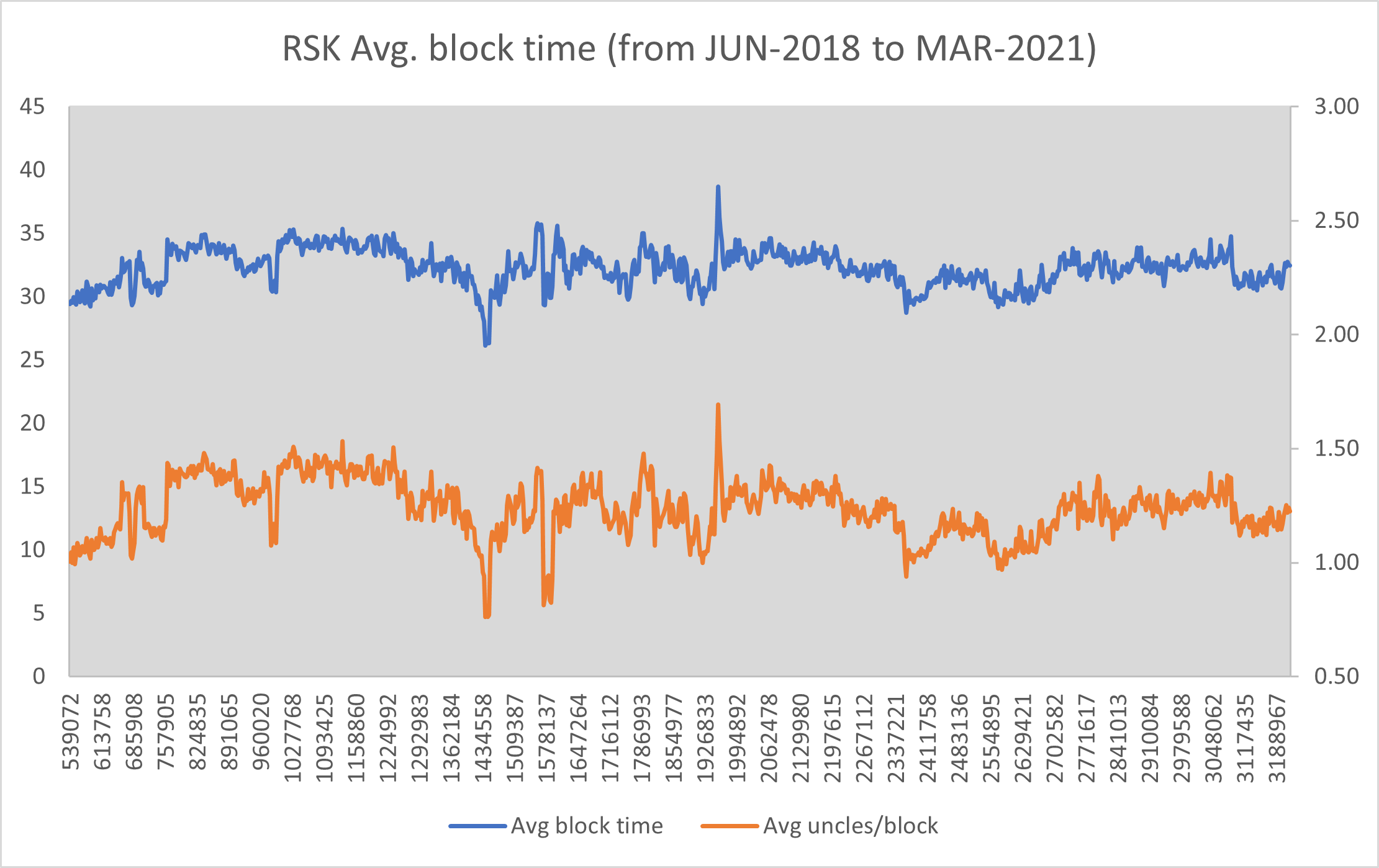I want to build a Solidity smart contract in RSK and Ethereum that pays dividends every year. Should I use the block time or can I rely on the block number, assuming a the current average inter-block time in RSK and Ethereum?
RSK and Ethereum have trunk blocks, which chained and executed, and uncle blocks (now called ommers), which are referenced but not executed. Both RSK and Ethereum have difficulty adjustment functions that try to maintain a target density of blocks (including trunk and ommers). In other words, a fixed number of blocks mined per time period. The adjustment functions in RSK and Ethereum are not equal, but both target a block density, not an inter-block time in the chain. Therefore, if the mining network produces a higher number of ommer blocks, the number of trunk blocks created over a period decreases, and the trunk average inter-block time increases. In the case of Ethereum, the number of ommers have oscillated between 5% and 40% in the last 5 years, but in the last 2 years it has stayed relatively stable between 4% and 8%. This translates to a +-2% error when measuring time based on block count. However, in Ethereum the “difficulty bomb” has affected the average block time much more than the ommer rate. The average block time is ~14 seconds now, but it has peaked to 30, 20 and 17 seconds at different times. Therefore, in Ethereum, the a number of blocks should not be used to measure long periods of time. It may be used only for short periods, not longer than a month. More importantly, if Ethereum switches to PoS, the average block interval will decrease to 12 seconds at that point.
Here we show the Ethereum ommer rate:
 (source: https://ycharts.com/indicators/ethereum_uncle_rate)
(source: https://ycharts.com/indicators/ethereum_uncle_rate)
And this is Ethereum average block time:
 (source: https://ycharts.com/indicators/ethereum_average_block_time)
(source: https://ycharts.com/indicators/ethereum_average_block_time)
The spikes are caused by the difficulty bomb and the abrupt decays by hard-forks that delayed the bomb.
In RSK, most miners are configured to minimize mining pool bandwidth and create a high number of ommers. This is permitted and encouraged by design. They can also be configured to minimize the number of ommers, and consume more bandwidth. RSK targets approximately a density of 2 blocks every 33 seconds, and currently one block is an ommer, and the other is part of the trunk. If the RSK/Bitcoin miners decide in the future to switch to the ommer-minimizing mode, almost no ommers will be created and the average trunk block interval will decrease to 16.5 seconds (to keep the 2 blocks per 33 seconds invariant). This is why, even if the trunk block interval in RSK is currently very stable, in the future (and without prior notice) it can suddenly change from 22 seconds down to 16.5 seconds. This makes the block number an unreliable source for computing the time for values such as the interest rate.
On the other hand, the block time cannot be easily forged because nodes check that block time is not in the future, and not prior to the parent block time. Also RSK has a consensus rule that ties RSK timestamp to Bitcoin timestamp, which makes cheating extremely expensive as the Bitcoin blocks back-dated or forward-dated produced by merge-mining would be invalid.
Here is the RSK average block time and average uncle rate from June 2018 to March 2021. The X-axis shows the block number.
 Each dot in the chart corresponds to a day. We can see that the block interval is highly correlated to the uncle rate.
Each dot in the chart corresponds to a day. We can see that the block interval is highly correlated to the uncle rate.
The EVM opcode NUMBER (which is used to obtain the block height) returns the number of trunk blocks, not considering ommers. As a consequence, the value returned cannot be used to count all types of blocks. However, a new opcode OMMERCOUNT could be added, to query the total number of ommers referenced up to the current block. Together with NUMBER, these opcodes could be used to better approximate the passage of time.
© 2022 - 2024 — McMap. All rights reserved.
